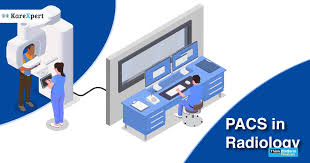How to Improve Diagnostic Imaging Efficiency with PACS Systems

In the evolving field of healthcare, technology plays a pivotal role in enhancing diagnostic processes and improving patient outcomes. One of the most significant innovations in healthcare technology is the Picture Archiving and Communication System (PACS). This system revolutionizes how healthcare facilities manage, store, and retrieve medical images, leading to improved diagnostic accuracy and operational efficiency. In this article, we’ll explore how PACS systems work, their benefits, and how healthcare providers can leverage them to streamline diagnostic imaging. To learn more about PACS systems and how they can improve healthcare services, visit SepStream’s PACS System Radiology page.
What is a PACS System?
A Picture Archiving and Communication System (PACS) is a medical imaging technology used to store, retrieve, manage, and share medical images electronically. Traditionally, medical images like X-rays, CT scans, MRIs, and ultrasounds were stored on film, making it challenging to access and share data between departments or facilities. With PACS, healthcare professionals can store digital images in a centralized system and access them remotely, enabling faster decision-making and collaboration.
At its core, PACS eliminates the need for physical films, reducing the costs associated with storing, transporting, and handling images. This digital transformation also accelerates the entire diagnostic workflow, improving patient care by providing timely access to imaging data.
Key Components of PACS Systems
A PACS system typically consists of several components that work together to deliver a seamless experience for healthcare providers. These components include:
- Imaging Modalities: These are the machines used to capture medical images, such as CT scanners, MRIs, and X-ray machines.
- PACS Server: The server stores all the medical images and associated data in a secure, centralized database.
- Workstations: These are computers used by healthcare professionals to view, analyze, and interpret the medical images.
- Networking and Communication Systems: These systems facilitate the transmission of images between different devices and locations, ensuring fast and reliable access to data.
- Archiving Solutions: These are used to store images over the long term, ensuring they are easily accessible for future reference or comparison.
How PACS Improves Diagnostic Imaging Efficiency
PACS systems bring significant improvements to diagnostic imaging by enhancing both the speed and accuracy of medical imaging processes. Let’s explore how:
1. Faster Access to Imaging Data
One of the primary advantages of PACS is the ability to access medical images instantly, no matter where the images were taken or where the healthcare provider is located. By eliminating the need for physical films, PACS allows medical staff to view images on their computers or mobile devices, significantly reducing the time spent searching for and retrieving images. This faster access to imaging data can be especially crucial in emergency situations, where quick decisions can save lives.
2. Improved Collaboration and Communication
With PACS, healthcare professionals—whether they are radiologists, surgeons, or specialists—can share and collaborate on imaging data more easily. This facilitates better communication and leads to more accurate diagnoses and treatment plans. For instance, a radiologist in one location can easily send an image to a specialist across the globe for a second opinion, making collaboration more efficient and timely.
3. Enhanced Image Quality and Analysis
Digital images stored in PACS systems are often of superior quality compared to traditional film images. This high-resolution imaging allows for more detailed analysis, improving diagnostic accuracy. PACS systems also offer advanced image manipulation tools that enable healthcare providers to zoom in on specific areas of the image, adjust contrast, and apply other enhancements, which can lead to more precise diagnoses.
4. Streamlined Workflow and Reduced Costs
By digitizing medical images, PACS systems streamline workflows by reducing the need for manual handling, storage, and transportation of physical films. This not only saves time but also reduces the costs associated with maintaining and storing large quantities of film. Additionally, healthcare facilities can cut down on the physical space required for storage, freeing up valuable resources for other purposes.
5. Long-Term Data Storage and Accessibility
PACS systems provide secure, long-term storage of medical images. Healthcare providers can archive images in the system and retrieve them as needed for future reference. This ensures that patients’ imaging data is accessible even years after the original diagnosis, making it easier to compare current images with historical ones, track changes over time, and manage ongoing treatments.
The Role of PACS in Digital Healthcare Solutions
As healthcare continues to transition toward digital solutions, PACS plays a vital role in the broader landscape of digital healthcare. The integration of PACS with electronic health records (EHRs) and other health information systems helps create a more comprehensive and interconnected healthcare environment. This integration enables healthcare providers to access both clinical and imaging data from a single platform, simplifying patient management and ensuring a holistic approach to care.
Moreover, the shift to digital imaging allows healthcare organizations to leverage data analytics and artificial intelligence (AI) tools. AI-powered imaging analysis can assist radiologists in detecting abnormalities in medical images with higher precision, reducing human error and improving diagnostic accuracy.
How SepStream Can Help Healthcare Providers with PACS Solutions
For healthcare organizations seeking to adopt or upgrade their PACS systems, SepStream offers robust PACS solutions designed to enhance the efficiency and effectiveness of diagnostic imaging. As a provider of Enterprise PACS Imaging Solutions, SepStream specializes in delivering affordable, high-quality systems tailored to the unique needs of healthcare and diagnostic imaging professionals.
SepStream’s PACS systems are equipped with advanced features such as secure cloud storage, fast image retrieval, and seamless integration with other healthcare systems, ensuring that healthcare providers can manage medical images with ease. These solutions not only help improve workflow efficiency but also contribute to better patient care by providing timely access to accurate imaging data.
To explore SepStream’s PACS solutions in more detail, visit their PACS System Radiology page.
The Future of PACS in Healthcare
The future of PACS systems in healthcare looks promising, with ongoing advancements in technology and digital solutions. As healthcare organizations continue to embrace digital transformation, PACS systems will evolve to incorporate new features such as enhanced AI-powered diagnostics, advanced image processing capabilities, and improved interoperability with other healthcare systems.
Additionally, the growing adoption of cloud-based PACS systems will enable healthcare providers to store and access images from virtually anywhere, improving mobility and flexibility for medical professionals. As these innovations unfold, PACS will remain a cornerstone of diagnostic imaging, contributing to better outcomes and more efficient healthcare delivery.
Conclusion
PACS systems have revolutionized diagnostic imaging by improving accessibility, collaboration, and image quality while reducing costs and inefficiencies. As the healthcare industry continues to embrace digital solutions, PACS systems will play an increasingly important role in enhancing the overall efficiency and effectiveness of healthcare services. By adopting advanced PACS solutions like those offered by SepStream, healthcare providers can ensure that they are equipped with the tools needed to deliver the highest level of care to their patients.
For more information on PACS systems and how they can improve your healthcare practice, visit SepStream’s PACS System Radiology page.



